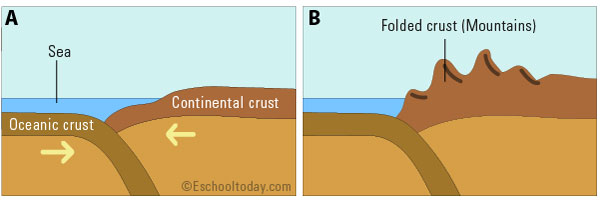- Landforms
What is a mountain landform?
Geologists consider any towering landform rising more than 1000ft or more above its surrounding area as a Mountain. Mountains are not hills. They are a lot larger, taller, and more dominating than hills. Mount Everest, in Nepal Asia, is known to be the highest mountain. It is about 8,848meters (29,028 ft) above sea level.

The top of a mountain is known as the Peak or Summit, the sides are the slopes, and the base is called the foot of the mountain. Mountains come in different forms, usually classified by how they are formed. Mountains are often found in groups, called mountain range. A mountain range that has the same origin is called a mountain system. Some big mountains like Everest have ice at the summits because it is cold up there.
Fault Block Mountains (also called Block Mountains)

Fault block mountains have very steep slopes on one side and gentle slopes on the other side. They are believed to be formed by faults in the earth’s crust. If the overlying earth material is brittle, tectonic forces acting against each other causes the faults to give way, and the earth is pushed upwards. Great examples of Block mountains include Rift Valley Zone in East Africa.
Folded Mountains
Fold mountains usually come in a range of folds, often stretching for hundreds of kilometers. They are formed when extreme converging pressure act on tectonic plates in the earth crust or a continental crust pushes against an oceanic crust (see illustration below)
The converging forces (A) causes the surface of the continental crust to fold (B). Great examples include The Himalayas Range of Mountains in Asia, one of which is the highest in the world, Mount Everest.
Volcanic mountains
Did you know that volcanoes are just openings in the earth’s crust through which lava comes out? Volcanoes are called mountains because when they spew out liquid rock (molten magma or lava) and they cool off, forming high landforms around the vent. That is why we call them volcanic mountains because they form when volcanoes erupt and produce lava. Good examples of volcanic mountains include Mount Fuji in Japan.
A dome mountain is another kind of volcanic mountain. In this case, the molten magma (liquid rock) does not spew out in an eruption but pushes out close to the surface of the crust. It cools off and solidifies into the hard rock just beneath the crust surface, pushing up the surface to form a dome.
A plateau mountain may also be a result of volcanic action, where lava from beneath the earth’s crust cools off and solidifies on the surface. High viscous lava form wider but shorter mountains, and low viscous lava form smaller but taller mountains.
